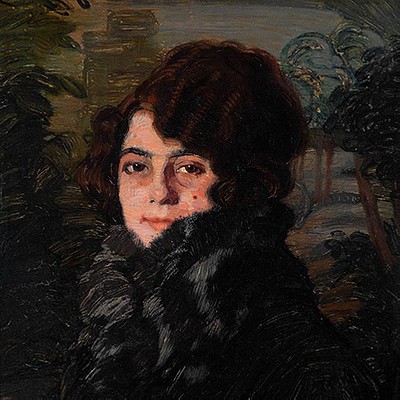JOAN LLIMONA BRUGUERA (Barcelona, 1860 - 1926). "Girl by the sea", 1923. Oil on canvas.
Lot 7
About Seller
Setdart Auction House
Carrer Aragó 346
Barcelona
Spain
Setdart Subastas was born in 2004 and is currently the first online art auction in Spain with solidity, prestige and reliability guaranteed by our more than 60,000 users. Setdart has a young, dynamic and enterprising team ready to successfully manage the purchase and sale of art works through custom...Read more
Estimate:
EUR€2,000 - EUR€2,500
$2,150.54 - $2,688.17
Absentee vs Live bid
Two ways to bid:
- Leave a max absentee bid and the platform will bid on your behalf up to your maximum bid during the live auction.
- Bid live during the auction and your bids will be submitted real-time to the auctioneer.
Bid Increments
| Price | Bid Increment |
|---|---|
| EUR€0 | EUR€10 |
| EUR€200 | EUR€25 |
| EUR€500 | EUR€50 |
| EUR€1,000 | EUR€100 |
| EUR€3,000 | EUR€200 |
| EUR€5,000 | EUR€500 |
| EUR€10,000 | EUR€1,000 |
| EUR€20,000 | EUR€2,000 |
| EUR€50,000 | EUR€5,000 |
About Auction
By Setdart Auction House
Jul 15, 2021
Set Reminder
2021-07-15 08:00:00
2021-07-15 08:00:00
America/New_York
Bidsquare
Bidsquare : 19th & 20th CENTURY PAINTINGS & ORIENTALISM
https://www.bidsquare.com/auctions/setdart-auction-house/19th-20th-century-paintings-orientalism-7212
Setdart Auction House sofia@setdart.com
Setdart Auction House sofia@setdart.com
- Lot Description
JOAN LLIMONA BRUGUERA (Barcelona, 1860 - 1926). "Girl by the sea", 1923. Oil on canvas. Signed and dated in the lower right corner. Size: 70 x 103 cm; 83 x 116 cm (frame). In this canvas Joan Llimona captures a clear, ordered and rational composition, of great sobriety, that drinks directly from the influence of the great symbolist masters, key in the development of art since the end of the 19th century in the main European artistic centers. Thus, Llimona shows us an intimate portrait, starring a young woman engrossed in her thoughts, totally oblivious to the presence of the viewer, concentrated, taciturn, whose finesse is determined by the delicate chromatism, which gently shapes the features and builds the space. Joan Llimona was born into a family of artists, his brother Josep was a famous sculptor also within modernism. He began studying architecture and engineering, but soon abandoned them for painting, which he perfected at the School of La Lonja, in Barcelona, and later in Rome, where between 1880 and 1882 he accompanied his brother, who had won a scholarship to study sculpture in that city. As early as 1882 he participated in some group exhibitions in Barcelona, which culminated in 1890 in a personal exhibition at the Sala Parés, which was extraordinarily well received. Deeply influenced by his militant Catholicism, which led him to a confrontation with the writer Raimon Casellas, he painted numerous works of religious content, including the vault of the Monastery of Montserrat. Llimona headed the Catholic split within the modernist movement, which materialized in the founding of the Círculo de Sant Lluc in 1893. In 1896 he won a first medal at the Fine Arts Exhibition in Barcelona. Towards 1905 his work was influenced by symbolism, always with religious roots, which is reflected, for example, in the painting of the dining room of the Casa Recolons in Barcelona. An excellent draughtsman, he oriented his work towards a religious mysticism of great sentimental charge, of careful form and contained expressiveness, deeply evocative. He published several articles in Barcelona magazines and newspapers such as "La veu de Catalunya", "La barretina", "Catalunya social" and others, almost always on aesthetic issues related to his rigid concept of morality and against blasphemy. He was a member of the Lliga del Bon Mot (literally, League of the Good Word), and of Foment de la Pietat Catalana, both associations defending a conservative concept of morality. He carried out important mural commissions for several Catalan churches, and is currently represented in the Museum of Contemporary Art of Barcelona and in the Archive-Museum of Ripoll, as well as in important private collections.
- Shipping Info
-
In-house shipping available. Please inquire at admin@setdart.com.
-
- Buyer's Premium



 EUR
EUR CAD
CAD AUD
AUD GBP
GBP MXN
MXN HKD
HKD CNY
CNY MYR
MYR SEK
SEK SGD
SGD CHF
CHF THB
THB
















